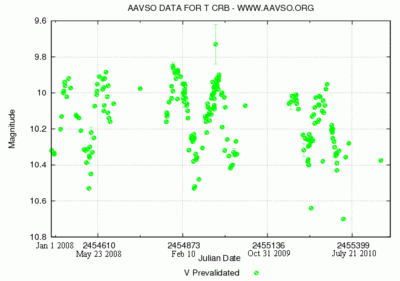T Coronae Borealis
| Observation data Epoch J2000 Equinox J2000 | |
|---|---|
| Constellation | Corona Borealis |
| Right ascension | 15h 59m 30.16s[1] |
| Declination | 25° 55′ 12.6″ |
| Apparent magnitude (V) | 2.0–10.8[1] |
| Characteristics | |
| Spectral type | M3III[1][2] / White Dwarf |
| Variable type | recurrent nova (NR)[1] |
| Astrometry | |
| Radial velocity (Rv) | 14.33[2] km/s |
| Parallax (π) | 1.61 ± 1.63[2] mas |
| Details | |
| Other designations | |
T Coronae Borealis (T CrB), informally nicknamed the Blaze Star,[3] is a recurring nova in the constellation Corona Borealis. It normally has a magnitude of about 10, which is near the limit of typical binoculars. It has been seen to outburst twice, reaching magnitude 2.0 on May 12, 1866 and magnitude 3.0 on February 9, 1946.[4] Though a more recent paper shows the 1866 outburst with a possible peak range of magnitude 2.5 ± 0.5.[5] Even when at peak magnitude of 2.5, this recurrent nova is dimmer than about 120 stars in the night sky.[6]

2016 Activity
On 20 April 2016, the Sky and Telescope newsletter reported a recent sustained brightening since February 2015 from magnitude 10.5 to about 9.2. A similar event was reported in 1938, shortly before the 1946 outburst. Closer observations are planned.
See also
References
- 1 2 3 4 "T CrB". AAVSO: Variable Star Plotter (VSP). Retrieved 2010-11-15.
- 1 2 3 4 "T Coronae Borealis". SIMBAD Astronomical Database. Retrieved 2010-11-15.
- ↑ A Digital Spectral Classification Atlas, R. O. Gray, 34. Unusual Stellar Spectra III: two emission-line stars
- ↑ Sanford, Roscoe F. (1949). "High-Dispersion Spectrograms of T Coronae Borealis.". Astrophysical Journal. 109: 81. Bibcode:1949ApJ...109...81S. doi:10.1086/145106.
- ↑ Schaefer, Bradley E. (2009). "Comprehensive Photometric Histories of All Known Galactic Recurrent Novae". arXiv:0912.4426
 .
. - ↑ "Vmag<2.5". SIMBAD Astronomical Database. Retrieved 2010-06-25.
Further reading
- Wallerstein, George; Tanya Harrison; Ulisse Munari; Andrew Vanture (11 May 2008). "The Metallicity and Lithium Abundances of the Recurring Novae T CrB and RS Oph". Publications of the Astronomical Society of the Pacific. 120 (867): 492–497. Bibcode:2008PASP..120..492W. doi:10.1086/587965.
- R and T Coronae Borealis: Two Stellar Opposites at Sky & Telescope
External links
- http://www.daviddarling.info/encyclopedia/B/Blaze_Star.html
- AAVSO: Quick Look View of AAVSO Observations (get recent magnitude estimates for T CrB)